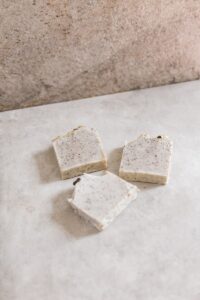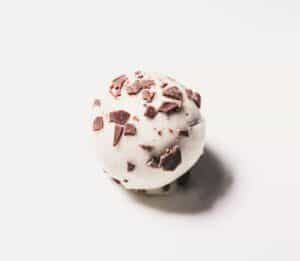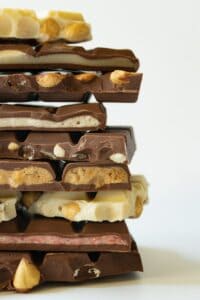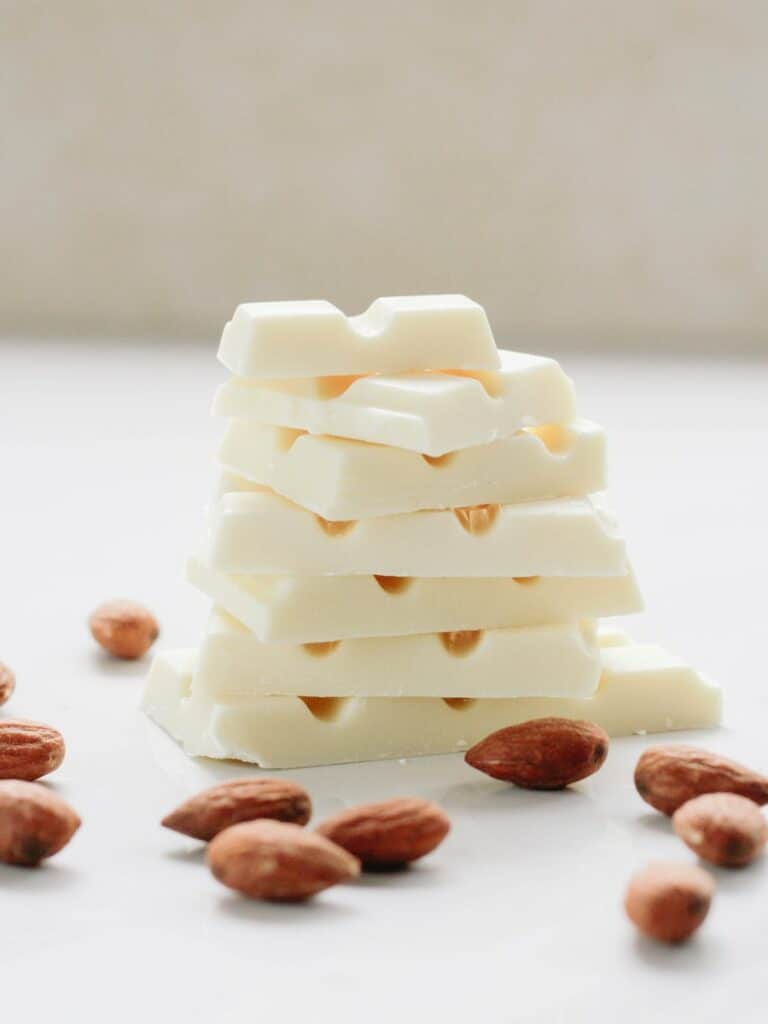Is white chocolate really chocolate? As a chocolate lover, I’ve often pondered over this question myself. The debate about whether white chocolate can be called “real” chocolate has been ongoing among those passionate about their chocolate varieties. In order to unravel this mystery, let’s dive into the world of cocoa beans and chocolate-making processes.
Chocolate comes in various shades and flavors, from dark chocolate to milk chocolate and everything in between. The primary difference between these varieties lies in their cocoa solids and cocoa butter content, which come from the ever-important cocoa bean (also referred to as cacao beans). Dark chocolate contains a higher percentage of cocoa solids, while milk chocolate has a higher proportion of milk powder and dairy milk. So, where does white chocolate fit into this equation?
White chocolate is made from cocoa butter, milk solids, and sweeteners. It lacks the cocoa solids found in its darker counterparts. This is the main reason some people argue that it doesn’t qualify as “real chocolate.” It’s worth noting that good quality white chocolate still contains a significant amount of cocoa butter (usually around 20% cocoa butter), which comes from the cocoa mass extracted during the processing of cocoa beans. This connection to the cocoa bean makes it reasonable for white chocolate to be considered a type of chocolate, albeit distinct from both dark and milk chocolate varieties. So, is white chocolate really chocolate? Well, it might not be the kind of chocolate you’re used to, but it certainly has its roots in the same key ingredient: the cocoa bean.

Understanding White Chocolate Ingredients
Many people wonder, _is white chocolate really chocolate_? To answer this question, it’s important to understand the ingredients that make up white chocolate and how it differs from milk chocolate and dark chocolate.
White chocolate is made using cocoa butter, which is extracted from cocoa beans. Unlike milk or dark chocolate, white chocolate doesn’t contain cocoa solids, the dark brown component found in the whole cocoa bean and responsible for the rich taste of real chocolate. Instead, white chocolate consists of cocoa butter, milk solids, and sugar.
The absence of cocoa solids in white chocolate means that it has a much lighter color than milk or dark chocolate. Milk chocolate is made by combining the chocolate liquor from ground cacao beans with milk, sugar, and extra cocoa butter. Dark chocolate contains a higher percentage of cocoa mass, which comes from the chocolate liquor, and less or no milk solids.
The history of white chocolate dates back to World War I, when excess milk powder was introduced to developing chocolate commercially to preserve dairy milk. It was then combined with cocoa butter, sugar, and vanilla to create the first white chocolate bar.
High-quality white chocolate should have a minimum of 20% cocoa butter. This is essential for a smooth texture and authentic chocolate flavor. To be considered good quality white chocolate, it should also contain milk solids, sugar, and optionally, vanilla or other flavors.
Unfortunately, some lower-quality white chocolate bars may use substitutes such as palm oil instead of cocoa butter, which can affect the taste and texture. When selecting a white chocolate bar, it’s essential to look for one with a high cocoa butter content and avoid those with vegetable oils or artificial flavors.

As a chocolate lover, it’s worth considering that, technically, white chocolate isn’t “real chocolate” due to the absence of cocoa solids. However, it still has its place among chocolate bars by offering a distinct, creamy taste and texture.
In conclusion, while white chocolate lacks the cocoa solids found in dark and milk chocolate, its basis in cocoa butter still connects it to the cocoa bean. Ultimately, whether or not white chocolate is deemed “real chocolate” comes down to personal preference and opinions on what defines chocolate. The next time you enjoy a white chocolate bar, remember the unique ingredients and process that went into making it.
Comparing White Chocolate to Dark and Milk Chocolate

When it comes to the question “Is white chocolate really chocolate?” we first need to understand the key differences between white chocolate, milk chocolate, and dark chocolate. The primary ingredient that distinguishes these three types of chocolate is the amount of cocoa solids derived from cocoa beans in each.
Dark chocolate has the highest cocoa content, consisting of cocoa mass, cocoa butter, and sometimes sugar. Milk chocolate includes all of the components found in dark chocolate, but with the addition of milk powder or milk solids, resulting in a lighter flavor and color. White chocolate, on the other hand, is primarily composed of cocoa butter, milk solids, and sugar, while containing no cocoa solids at all.
Despite lacking cocoa solids, white chocolate can still be considered real chocolate due to the presence of cocoa butter, which is derived from cacao beans. In fact, in order to be classified as white chocolate by the FDA, a product must contain at least 20% cocoa butter, along with a minimum of 14% milk solids and 3.5% milk fat. However, there remains a great deal of variation in the quality of white chocolate available on the market.
Good quality white chocolate contains a higher percentage of cocoa butter, providing a richer, creamier taste and texture. Lower quality white chocolate, however, may substitute palm oil or other fats for some of the cocoa butter, leading to an inferior product. As a result, chocolate lovers may have mixed opinions on whether or not white chocolate is on the same level as its dark and milk counterparts.
The development of white chocolate began during World War I, when Swiss chocolatiers sought to utilize excess milk powder by combining it with cocoa butter and sugar. The Nestlé company was the first to develop white chocolate commercially, introducing the first white chocolate bar in 1930. Since then, white chocolate bars have become a popular treat around the world, despite the ongoing debate about their status as real chocolate.
To summarize, while white chocolate doesn’t contain cocoa solids, it’s still considered real chocolate thanks to its cocoa butter content. The debate on whether white chocolate is on par with dark and milk chocolate ultimately comes down to individual taste and preferences, as well as the quality of the white chocolate bar in question.
Final Thoughts: Is White Chocolate Truly Chocolate?
So, is white chocolate really chocolate? It’s a topic that has sparked debate among chocolate enthusiasts for years. Let’s take a deeper dive into the world of white chocolate and see if it deserves the title of “chocolate.”
White chocolate is made from cocoa butter, milk, sugar, and sometimes vanilla. Unlike milk chocolate and dark chocolate, however, it does not contain cocoa solids or cocoa powder, which come from the cocoa bean. Instead, it relies on cocoa butter (a fatty component) to give it its creamy texture and unique flavor.
– Milk Chocolate contains cocoa butter, milk, sugar, and cocoa solids
– Dark Chocolate contains cocoa butter, sugar, and cocoa solids
– White Chocolate contains cocoa butter, milk, sugar, but no cocoa solids
To be considered real chocolate, a product generally needs to contain a combination of cocoa butter, cocoa solids, and sugar. Chocolate bars you see at the store vary in their cocoa content – some bars contain as little as 20% cocoa butter, while white chocolate must have at least 20% cocoa butter content. Having no cocoa solids, white chocolate seems to set itself apart from the other types.
White chocolate as we know it today was first developed commercially in the 1930s, as the Nestlé company began combining excess milk powder with cocoa butter to produce a new, sweeter product. This first white chocolate bar was an attempt to use up excess milk solids remaining after World War I, when there was a surplus of powdered milk.
By definition, it seems white chocolate strays from the traditional idea of “real” chocolate. The absence of cocoa solids (which come from cacao beans) and the inclusion of extra cocoa butter in its recipe makes it stand out as a different product. But this doesn’t mean that white chocolate cannot be enjoyed by chocolate lovers.
Quality white chocolate bars, made with a high cocoa butter content and without additives like palm oil, may still be considered a chocolate delight by many. It might not share the same characteristics as dark or milk chocolate, but it has its unique appeal. The debate will likely continue, but in the end, it all comes down to personal preference.
To summarize:
– White chocolate is made from cocoa butter, milk, sugar, and occasionally vanilla
– It does not contain cocoa solids like milk and dark chocolate
– The first white chocolate bar was created in the 1930s by Nestlé
– Some people consider white chocolate to be “real” chocolate, while others disagree
Even though it may not fit the traditional mold of chocolate, white chocolate still has its place in our hearts (and taste buds). So whether you’re a purist who only indulges in the darkest of chocolate bars or a fan of something a little lighter, there’s room at the table for every type of chocolate lover.
